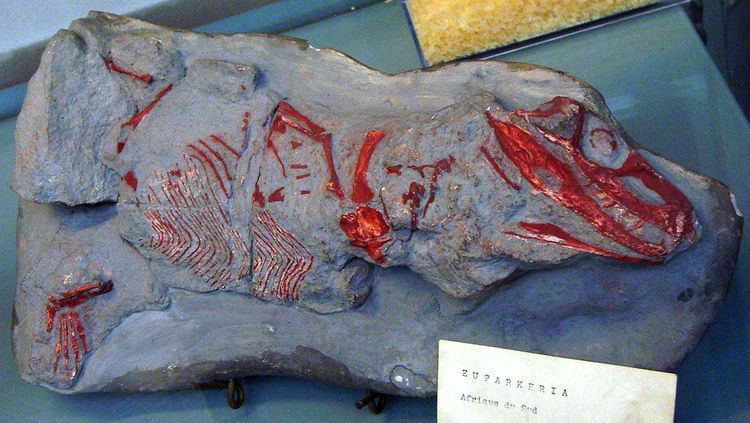Class Reptilia | Phylum Chordata Clade Eucrocopoda | |
 | ||
Family †EuparkeriidaeHuene, 1920 | ||
Euparkeriidae is a family of small basal archosauromorph carnivores which lived from the Early Triassic to the Middle Triassic (Anisian). While most other early archosauriforms walked on four limbs, euparkeriids were probably facultative bipeds that had the ability to walk on their hind limbs at times. The only definitive member of Euparkeriidae is the species Euparkeria capensis, which was named by paleontologist Robert Broom from the Karoo Basin of South Africa in 1913 and is known from several nearly complete skeletons. The family name was first proposed by German paleontologist Friedrich von Huene in 1920; Huene classified euparkeriids as members of Pseudosuchia, a traditional name for crocodilian relatives from the Triassic (Pseudosuchia means "false crocodiles"). Recent phylogenetic analyses place Euparkeriidae as a basal group of Archosauriformes, a position outside Pseudosuchia and close to the ancestry of both crocodile-line archosaurs and bird-line archosaurs (which include dinosaurs and pterosaurs). However, they are probably not direct ancestors of archosaurs.
Several other species have been assigned to the family, but several recent studies suggest that Euparkeriidae may not represent a true evolutionary grouping or clade. Instead, the family may represent an evolutionary grade of small archosauriforms (making it paraphyletic) or a group of species that each evolved small body sizes through evolutionary convergence (making it polyphyletic).
Classification
Besides Euparkeria, the most completely known putative euparkeriid is Osmolskina czatkowicensis. Several hundred isolated bones have been found in Poland, but they do not display any synapomorphies or shared characteristics with Euparkeria that would suggest a close evolutionary relationship. A 2010 phylogenetic analysis found that Osmolskina was more distantly related to Euparkeria than had previously been suspected. Dorosuchus neoetus, a Russian archosauriform known mostly by hind limb bones, has also been proposed as a possible euparkeriid. Three species from China have also been proposed as euparkeriids: Halazhaisuchus qiaoensis, "Turfanosuchus" shageduensis, and Wangisuchus tzeyii. The Russian and Chinese species have never been included together in a phylogenetic analysis. Moreover, their anatomical features are poorly known given the fragmentary states of the fossil material. There is currently little evidence to suggest that all these species belong within Euparkeriidae. Instead, Euparkeriidae may be a monotypic family with Euparkeria as its only representative.
Sookias et al. (2014) analysed many species that have been considered euparkeriids, finding many outside the group while recovering a slightly supported monophyletic family including "Turfanosuchus" shageduensis, Halazhaisuchus, and Euparkeria. However, "Turfanosuchus" shageduensis and Wangisuchus were both also found to be nomen dubium. Their cladogram is shown below. A Bayesian consensus tree resolved the trichotomy within Euparkeriidae and recovered Halazhaisuchus and Osmolskina as sister taxa. However, other parts of the tree lost much resolution creating a large polytomy of large groups above Erythrosuchidae.
